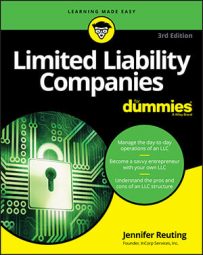A sole proprietorship automatically exists whenever you engage in business by and for yourself, without partners and without the protection of an LLC, corporation, or limited partnership. Although it sounds fancy and complicated, forming a sole proprietorship is about as easy as it gets.
Forming a sole proprietorship
When you begin transacting business, be it selling crafts at the local art fair or doing web design work in your spare time, you become a sole proprietor. Your state, city, and/or county may impose some business license requirements and fees on you in order for you to be allowed to do business in your current location, but aside from those few formalities, you’re in business.
To do business under a name other than your own, you can file a fictitious firm name statement (also called a DBA) with your county clerk. A DBA enables you to market your services under the name “Super-Duper Fantastic Web Design” rather than simply “John Smith.”
There are a few drawbacks to sole proprietorships. Namely, even if you file a DBA, you’re still a sole proprietorship. So, although you may be operating under a name other than your own, don’t get any lofty ideas that your business is anything other than just you. A DBA offers no barrier of legal separation between your business and yourself, and that fact should scare you.
Shouldering full liability: The buck stops with you
Even though a sole proprietorship is simple to set up, it has many disadvantages. When you operate as a sole proprietorship, your personal assets are unconditionally at risk from being seized by an angry creditor or a lawsuit gone bad.
There is an old saying, “You aren’t in business until you’ve been sued,” and as a sole proprietorship, you’re handing over all your hard-earned assets (your home, your car, everything) on a silver platter.
Sole proprietorships are popular because they are super cheap and easy to form. You start selling a product or service and generate your first dollar of revenue and boom — you’re a sole proprietorship.
However, if the business you’re pondering involves any interaction with the public, the costs you could find yourself facing can quickly eclipse whatever start-up fees you were trying to avoid in the first place. You won’t think that they’re so cheap and easy if you lose everything you own.
Exploring some more disadvantages
Here are a few other drawbacks to ponder:
Limited financing options. Unlike LLCs, which have membership interests, sole proprietorships don’t have interests or any other form of ownership in the company. Your business is you, and you can’t sell little pieces of yourself. This setup creates quite the conundrum if you want to raise money for your new venture by selling ownership interests.
No separate credit. As an unincorporated entity, you cannot obtain credit in the name of the business. You’re stuck using your own personal credit for things such as business loans and leases.
Limited life span. With no legal separation between you and your business, your business is subject to the same limitations that you are: namely, your lack of immortality. In other words, your business dies when you do. After you pass away, instead of carrying on in one piece, your business goes through probate, and your business assets are ripped apart and possibly even liquidated.
All these disadvantages don’t change the fact that sole proprietorships are easy. You don’t have to do anything to form one, and you don’t have to worry about recordkeeping requirements, keeping separate accounts, or accidently commingling funds like you would with a limited liability company or corporation.
In a sole proprietorship, you get the benefit of being autonomous. You are the business; therefore, you answer to nobody.
At the end of the day, you need to decide whether going through the trouble and expense of forming your business as an LLC is worth your while.
When you go into business, you need to be under the protection of an LLC or a corporation; however, before undertaking the formation process, operating as a sole proprietor for a bit to test your market is okay.
Losing LLC benefits with disregarded entity taxation
Like the courts, the IRS doesn’t consider a sole proprietorship to be separate from its owner, which is why the IRS treats it as a disregarded entity. Disregarded entities have a form of taxation often referred to as pass-through taxation, because the business isn’t taxed directly. Instead, the revenues and expenses of the business pass through and are taxed directly to the owner.
To calculate business profits and losses, you add a Schedule C to your 1040. On one side of the Schedule C, you list your business revenue; on the other side, you list your business expenses. Subtract one from the other and — voilà! — you get your net profit or net loss. You transfer this number to your 1040 and incorporate the income (or loss) into your normal tax burden.
Before applying your normal income tax rate to your business profits, you need to factor in a 15.3 percent self-employment tax. This tax serves as a substitute for Social Security and Medicare taxes that would normally be taken out of your paycheck. Shocked by the amount?
Well, you may not realize it, but when you pay the 6.2 percent Social Security tax and the 1.45 percent Medicare tax out of your salary each week, your employer has to match it. Now that you are working for yourself, you get the full burden: 12.4 percent Social Security plus 2.9 percent Medicare equals a whopping 15.3 percent!
Make more than most? At higher income levels, you pay an additional 0.9 percent Medicare tax! Luckily, to ease the burden a bit, the IRS allows you to deduct half the total amount of the self-employment tax.

